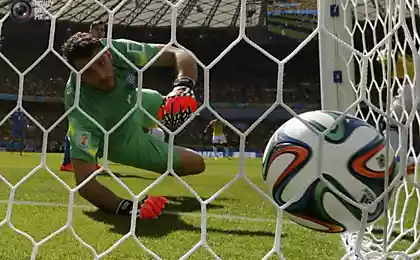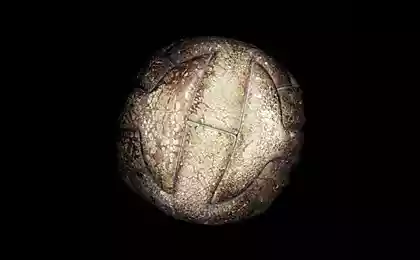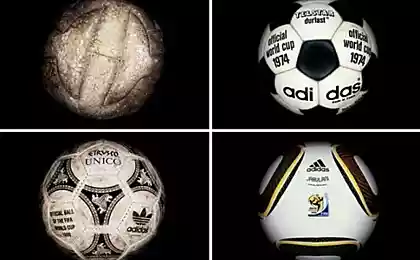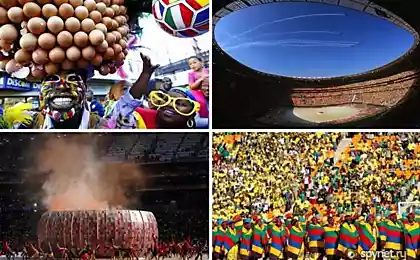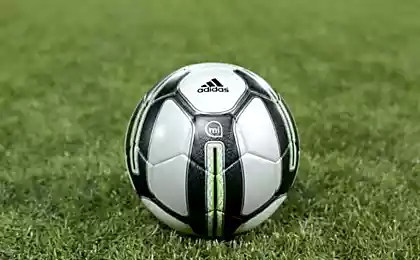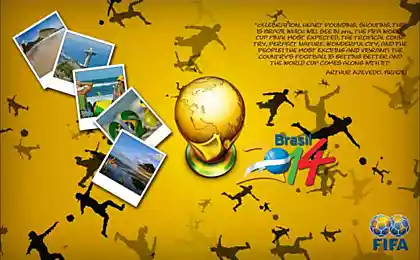748
All official World Cup balls
Before 1970, the official tournament to use any balls that clearly meet all the requirements of FIFA in weight and diameter of the circle. Official size and weight were established in 1872. In 1937, the weight was increased from 13-15 to 14-16 ounces ounces. The encyclopedia of football (English edition 1956) reads as follows: "According to the rules of football, the ball shall be spherical with an external coating of leather or other approved materials. The circle must not be less than 27 inches nor more than 28 inches, and the weight of the ball at the beginning of the game shall not be less than 14 ounces and more than 16 ounces.

And from 1970 to consistency began to use "the official ball of the tournament." The first "official" ball in football became «Telstar» Adidas at the World Cup in 1970 in Mexico. Now, a great match for each developed a unique new soccer ball.
«Telstar» Mexico-1970

«Telstar» Durlast - Germany 1974
At the World Cup in Germany in 1974 "participated" in two balls. For Ball Telstar it is was the second appearance, but the logo was no longer gold, and black. Adidas company also introduced a white version of the ball - adidas Chile - in honor of the all-white ball World Cup 1962 in Chile. From 1970 Telstar they differ only in pattern, materials and technology have remained the same.

«Tango Riverplate» - Argentina 1978
In 1978 the world was introduced adidas Tango - model, which later became the "classic design". Although the ball was sewn from the same panels 32, 20 of identical pattern of triads gave the impression of 12 circles, encircling the ball. The design of the official balls the next five FIFA championships was based precisely on this idea. Tango had also more resistant to weathering.

«Tango Espana» - Spain 1982
In 1982, the design Tango 1978 changed slightly. But technological change Tango Espana were more significant. The ball is still sewn leather, but the seams are taped and made watertight. This greatly increased abrasion resistance and reduced water absorption of the ball, and hence minimize an increase in weight in wet weather.

«Azteca» - Mexico 1986
This is the first official ball Championship FIFA, made from synthetic materials. As a result, the service life is significantly increased, and the water absorption decreased. Azteca has excellent performance when playing on hard surfaces at high altitude, and in wet weather, it was a significant step forward. Triad encircling the ball, were decorated with ornaments Aztec.

«Etrvsco» - Italy 1990
When creating adidas Etrusco Unico used only synthetic materials. Etrusco Unico was the first ball, the inner layer is made of a polyurethane foam, allowing the ball became more lively, fast and completely waterproof. The name and design captured the influence of ancient Italian history and cultural heritage of the Etruscans. Three heads etruskskih lions adorn each of the 20 triads.

«Questra» - USA 1994
The official ball of the championship in 1994 - the embodiment of high technology. Using the internal layer of polyurethane foam energovozvraschayuschego let the ball be softer (ie, obedient) and much faster. Inspired by space technology and the desire for American stars (Quest for the Stars, hence the name), Questra set new standards.
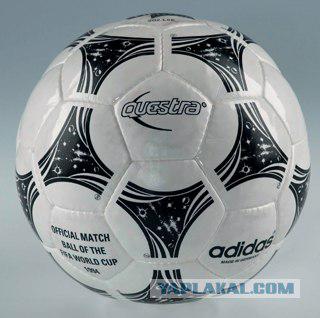
«Tricolore» - France 1998
The first official color ball championship. French flag and a rooster tail, a traditional symbol of France and the French Football Federation, reflected in the title and design. The adidas Tricolore was used synthetic foam layer with a regular array of durable micro-cells filled with gas. This structure provides durability and good tactile contact with the ball.

«Fevernova» - Japan and Korea in 2002
This is the first official ball design that differs from traditional ball Tango in 1978. Drawing and color palette inspired by Fevernova culture of the Far East. A special layer of synthetic foam helped to improve the characteristics of the ball, and three-layer fabric frame provides greater accuracy and predictability of the impact trajectory.

«Teamgeist» - Germany 200
For the first time in 36 years, adidas has receded from the classic 32-panel design. The frame and panels, connected by technology termoskleyki provide water resistance and a smooth surface, improve the effectiveness of strikes. The image is in black and white - the traditional colors of the German national team, with gold trim - a symbol of the World Cup, and is covered with a transparent protective layer. Teamgeist means "team spirit."

«Jabulani» - South Africa 2010
The word "Yabulani" means "happiness, celebrating" the language isiZulu, one of the 11 official languages adopted in South Africa. The design of the ball used 11 colors to honor not only the 11 official languages, but 11 communities in South Africa and the 11 players on the football team. In addition, 11 colors also remind us of the fact that this ball is the eleventh official ball designed for the World Cup.
The ball is made entirely from 100% thermoplastic polyurethane. The easiest ball. The most aerodynamic ball.

And again, in South Africa on April 20 was held the official presentation of the ball, which will be used in the final game of the World Cup July 11, 2010. The new production of "Adidas" is called "Yobulani" as opposed to "Yabulani", which will be applied in the remaining meetings of the championship. The first letters in the name taken from the name of the ball the economic capital of South Africa - Johannesburg, which will host the final of the championship.
The ball finals painted white, against which the striking three green triangle with rounded tops of the golden stripes with green piping. This is only the second time in history, when the finals of the World Cup to develop special sports equipment - the first time the organizers did it in 2006 in Germany.
The surface of the ball is provided with a high-profile, stabilizing the flight path and fixing the ball into the goalkeeper gloves.

Source:

And from 1970 to consistency began to use "the official ball of the tournament." The first "official" ball in football became «Telstar» Adidas at the World Cup in 1970 in Mexico. Now, a great match for each developed a unique new soccer ball.
«Telstar» Mexico-1970

«Telstar» Durlast - Germany 1974
At the World Cup in Germany in 1974 "participated" in two balls. For Ball Telstar it is was the second appearance, but the logo was no longer gold, and black. Adidas company also introduced a white version of the ball - adidas Chile - in honor of the all-white ball World Cup 1962 in Chile. From 1970 Telstar they differ only in pattern, materials and technology have remained the same.

«Tango Riverplate» - Argentina 1978
In 1978 the world was introduced adidas Tango - model, which later became the "classic design". Although the ball was sewn from the same panels 32, 20 of identical pattern of triads gave the impression of 12 circles, encircling the ball. The design of the official balls the next five FIFA championships was based precisely on this idea. Tango had also more resistant to weathering.

«Tango Espana» - Spain 1982
In 1982, the design Tango 1978 changed slightly. But technological change Tango Espana were more significant. The ball is still sewn leather, but the seams are taped and made watertight. This greatly increased abrasion resistance and reduced water absorption of the ball, and hence minimize an increase in weight in wet weather.

«Azteca» - Mexico 1986
This is the first official ball Championship FIFA, made from synthetic materials. As a result, the service life is significantly increased, and the water absorption decreased. Azteca has excellent performance when playing on hard surfaces at high altitude, and in wet weather, it was a significant step forward. Triad encircling the ball, were decorated with ornaments Aztec.

«Etrvsco» - Italy 1990
When creating adidas Etrusco Unico used only synthetic materials. Etrusco Unico was the first ball, the inner layer is made of a polyurethane foam, allowing the ball became more lively, fast and completely waterproof. The name and design captured the influence of ancient Italian history and cultural heritage of the Etruscans. Three heads etruskskih lions adorn each of the 20 triads.

«Questra» - USA 1994
The official ball of the championship in 1994 - the embodiment of high technology. Using the internal layer of polyurethane foam energovozvraschayuschego let the ball be softer (ie, obedient) and much faster. Inspired by space technology and the desire for American stars (Quest for the Stars, hence the name), Questra set new standards.

«Tricolore» - France 1998
The first official color ball championship. French flag and a rooster tail, a traditional symbol of France and the French Football Federation, reflected in the title and design. The adidas Tricolore was used synthetic foam layer with a regular array of durable micro-cells filled with gas. This structure provides durability and good tactile contact with the ball.

«Fevernova» - Japan and Korea in 2002
This is the first official ball design that differs from traditional ball Tango in 1978. Drawing and color palette inspired by Fevernova culture of the Far East. A special layer of synthetic foam helped to improve the characteristics of the ball, and three-layer fabric frame provides greater accuracy and predictability of the impact trajectory.

«Teamgeist» - Germany 200
For the first time in 36 years, adidas has receded from the classic 32-panel design. The frame and panels, connected by technology termoskleyki provide water resistance and a smooth surface, improve the effectiveness of strikes. The image is in black and white - the traditional colors of the German national team, with gold trim - a symbol of the World Cup, and is covered with a transparent protective layer. Teamgeist means "team spirit."

«Jabulani» - South Africa 2010
The word "Yabulani" means "happiness, celebrating" the language isiZulu, one of the 11 official languages adopted in South Africa. The design of the ball used 11 colors to honor not only the 11 official languages, but 11 communities in South Africa and the 11 players on the football team. In addition, 11 colors also remind us of the fact that this ball is the eleventh official ball designed for the World Cup.
The ball is made entirely from 100% thermoplastic polyurethane. The easiest ball. The most aerodynamic ball.

And again, in South Africa on April 20 was held the official presentation of the ball, which will be used in the final game of the World Cup July 11, 2010. The new production of "Adidas" is called "Yobulani" as opposed to "Yabulani", which will be applied in the remaining meetings of the championship. The first letters in the name taken from the name of the ball the economic capital of South Africa - Johannesburg, which will host the final of the championship.
The ball finals painted white, against which the striking three green triangle with rounded tops of the golden stripes with green piping. This is only the second time in history, when the finals of the World Cup to develop special sports equipment - the first time the organizers did it in 2006 in Germany.
The surface of the ball is provided with a high-profile, stabilizing the flight path and fixing the ball into the goalkeeper gloves.

Source:
